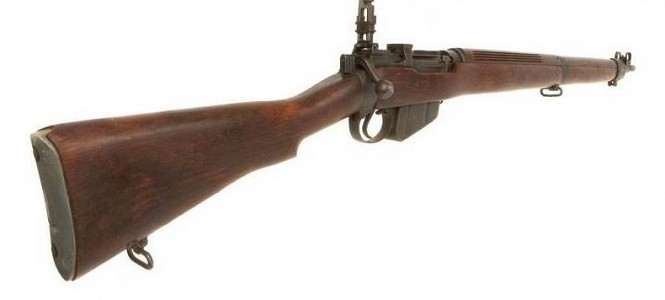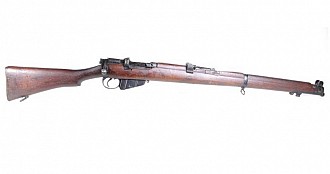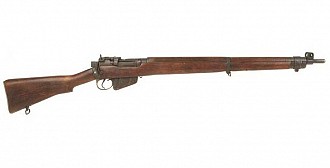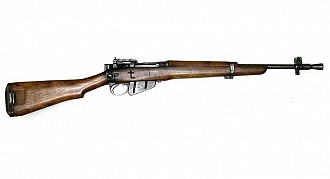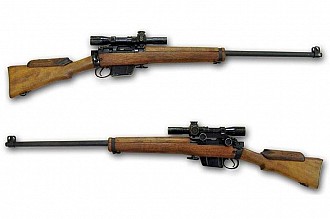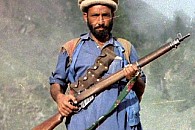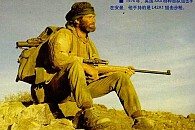Firearms / Assault rifles / Lee-Enfield
Lee-Enfield
General Facts
- TYPE
Bolt-action rifle - ORIGIN
 United Kingdom
United Kingdom - NICKNAMES
Short Magazine Lee-Enfield / SMLE
Smelly (from SMLE)
2A rifle (Indian production) - DESIGNED
1890 (old models)
1904 (SMLE) - DESIGNER
James Paris Lee & RSAF Enfield - PRODUCTION
1907 - 1957 (UK production)
1944 - 1947 (No.5)
1970 - 1970's (L42A1) - PRODUCERS
 Australia - Lithgow
Australia - Lithgow
 Canada - Longbranch Arsenal
Canada - Longbranch Arsenal
 India - Ishapore
India - Ishapore
 Pakistan - POF
Pakistan - POF
 United Kingdom - BSA
United Kingdom - BSA
 United Kingdom - Royal Ordnance Factory
United Kingdom - Royal Ordnance Factory
 United Kingdom - RSAF Enfield
United Kingdom - RSAF Enfield
 United States - Savage Arms
United States - Savage Arms - QUANTITY
Over 17 million produced, including about 250.000 No.5 - UNIT COST
Unknown - CHARACTERISTICS
 Good accuracy and long range
Good accuracy and long range
 Rugged and reliable
Rugged and reliable
 Limited rate of fire
Limited rate of fire
 Cumbersome and heavy
Cumbersome and heavy
Introduction
The Lee Enfield is a bolt action rifle of British origin. The original models were developed in the late 19th century. The Short Magazine Lee Enfield, or SMLE, was introduced in 1907 and became an iconic rifle for its use in World War 1 and 2.
Design
The Short Magazine Lee Enfield is a rather convention bolt action rifle. The Lee-Enfield has a unibody wooden furniture which extends nearly the full length of the barrel. The internal magazine is loaded from the top when the bolt is in the rear position. A limited number of rifles was fitted with optical sights for use as a sniper rifle.
Firepower
The Lee-Enfield fires the .303 British round from a 10 round internal magazine. The magazine is reloaded round by round or using 5 round stripper clips. The Lee-Enfield is known for its accuracy and reliability. The iron sights limit its maximum range to 500 meters while optics allow it to be used up to 800 meters. As a bolt-action rifle its rate of fire is rather low.
Users
The Lee-Enfield was the standard issue rifle in for the United Kingdom World War 1 and 2. It was used by most Commonwealth nations. After World War 2 is was replaced in most nations by battle rifles such as the FAL. It remained in limited service during the early Cold War era with third world nations. Some Lee-Enfields remain in law enforcement use, especially in India.
No.1 rifle
The No.1 rifle designation was applied to the old Mk I and Mk III designs in 1926. The Mk III is the first of the iconic Lee Enfield rifles.
No.1 Mk I: Original Short Magazine Lee Enfield introduced in 1904.
No.1 Mk III: Improved Mk I with redesigned magazine, rear sight and bayonet. Is the first model to use the new spitzer bullet version of the .303 round.
No.1 Mk III*: A No.1 Mk III with simpler sights.
- Specifications:
- No.1 Mk I
- No.1 Mk III
| Type | Bolt-action rifle |
|---|---|
| Caliber | .303 British |
| Magazine | 10 round detachable box magazine |
| Operation | Bolt-action |
| Fire selector | 0-1 |
| Rate of fire | Bolt-action |
| Barrel length | 640 mm |
|---|---|
| Rifling | ? |
| Muzzle velocity | 744 m/s |
| Stock | Fixed |
| Length | 1.130 mm |
| Width | ? |
| Height | ? |
|---|---|
| Weight | 4 kg |
| Sights | Iron sights, barley corn front and tangent leaf rear |
| Remarks | - |
| Type | Bolt-action rifle |
|---|---|
| Caliber | .303 British |
| Magazine | 10 round detachable box magazine |
| Operation | Bolt-action |
| Fire selector | 0-1 |
| Rate of fire | Bolt-action |
| Barrel length | 640 mm |
|---|---|
| Rifling | ? |
| Muzzle velocity | 744 m/s |
| Stock | Fixed |
| Length | 1.130 mm |
| Width | ? |
| Height | ? |
|---|---|
| Weight | 4 kg |
| Sights | Iron sights, blade front and tangent leaf rear |
| Remarks | - |
No.4 rifle
The No.4 rifle is based on the No.1 Mk IV but both more durable and easier to produce. It was developed in the late 1930's and officially adopted in 1941.
No.4 Mk I: Original No.4 rifle produced in the UK.
No.4 Mk I*: Easier to produce version of the No.4 Mk I that was produced in the USA and Canada.
No.4 Mk I(T): A No.4 Mk I fitted with telescope sight for use as a sniper rifle. The No.4 Mk I*(T) is based on the Mk I*.
No.5 Mk 2: Post World War 2 UK production model with revised trigger design and beech wood stock. Many older rifles were brought up to this standard.
- Specifications:
- No.4 Mk I
| Type | Bolt-action rifle |
|---|---|
| Caliber | .303 British |
| Magazine | 10 round detachable box magazine |
| Operation | Bolt-action |
| Fire selector | 0-1 |
| Rate of fire | Bolt-action |
| Barrel length | 640 mm |
|---|---|
| Rifling | ? |
| Muzzle velocity | 744 m/s |
| Stock | Fixed |
| Length | 1.130 mm |
| Width | ? |
| Height | ? |
|---|---|
| Weight | 4 kg |
| Sights | Iron sights, blade front and vertical leaf rear |
| Remarks | - |
No.5 jungle carbine
The No.5 Jungle carbine was developed late in World War 2 to meet the demand for a more compact rifle. The jungle carbine has a shorter barrel with prominent flash hider, a shorter stock and shorter forward grip.
No.5 Mk I: Carbine based on the No.4 rifle, produced in the UK.
No.6 Mk I: Carbine based on the Mk III rifle, produced in small quantities in Australia.
- Specifications:
- No.5 Mk I
| Type | Bolt-action rifle |
|---|---|
| Caliber | .303 British |
| Magazine | 10 round detachable box magazine |
| Operation | Bolt-action |
| Fire selector | 0-1 |
| Rate of fire | Bolt-action |
| Barrel length | 475 mm |
|---|---|
| Rifling | ? |
| Muzzle velocity | 732 m/s |
| Stock | Fixed |
| Length | 1.003 mm |
| Width | ? |
| Height | ? |
|---|---|
| Weight | 3.2 kg empty |
| Sights | Iron sights, blade front and vertical leaf rear |
| Remarks | - |
L42 sniper rifle
The L39A1 is a target rifle based on the No.4 rifle. It is chambered in 7.62x51mm NATO and has a cold forged heavy barrel, shorter handguard and is fitted with precision iron sights. The civilian version is called Envoy.
The L42A1 is a sniper rifle based on the L39A1 design. It was introduced in 1970 and was in British service until the 1990's. Unlike the other Lee-Enfields it fires the 7.62x51mm NATO round. The law enforcement and civilian version is called Enforcer.
| Type | Bolt-action rifle |
|---|---|
| Caliber | 7.62x51mm NATO |
| Magazine | 10 round detachable box magazine |
| Operation | Bolt-action |
| Fire selector | 0-1 |
| Rate of fire | Bolt-action |
| Barrel length | 700 mm |
|---|---|
| Rifling | 4 grooves, 305 mm right hand twist |
| Muzzle velocity | 841 m/s |
| Stock | Fixed |
| Length | 1.180 mm |
| Width | ? |
| Height | ? |
|---|---|
| Weight | 4.42 kg emtpy |
| Sights | Iron sights, 830 mm sight radius |
| Remarks | - |
| Type | Sniper rifle |
|---|---|
| Caliber | 7.62x51mm NATO |
| Magazine | 10 round detachable box magazine |
| Operation | Bolt-action |
| Fire selector | 0-1 |
| Rate of fire | Bolt-action |
| Barrel length | 699 mm |
|---|---|
| Rifling | 4 grooves, 305 mm right hand twist |
| Muzzle velocity | 838 m/s |
| Stock | Fixed |
| Length | 1.181 mm |
| Width | ? |
| Height | ? |
|---|---|
| Weight | 4.43 kg empty without optics |
| Sights | Optical sight, backup iron sights |
| Remarks | - |

